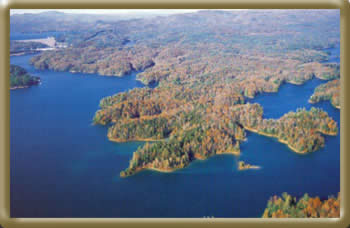 |
|
Located just 45 miles from Greenville, South Carolina, Lake Keowee provides a majestic view, beautiful fresh water lakes, and mountain views. The lake is located close to the small town of Seneca in the northwest corner of the state of South Carolina. Lake Keowee consists of about 18,000 acres and approximately 300 miles of shoreline. Only a small percentage of the shoreline has been developed, resulting in an uncrowded lake. Boating, sailing, fishing, and a variety of outdoor activities are popular in this region. Other recreational attractions in the vicinity include white-water rafting, visiting Jocassee State Park (15 miles away), enjoying the Chattooga River, touring Cross Creek Plantation, and visiting Clemson University (7 miles away). |
Beneath Lake Keowee lies memories of the once fertile and prosperous Keowee Valley. The Valley was lush with abundant wildlife and feed by the mighty Keowee River. However, this valley was also home to over 400 Cherokee Indians at there capital, Keowee Village, on the banks of the Keowee River. It was once noted that in 1721 that 450 Cherokees lived at the village consisting of 168 men, 155 women and 127 children. The centerpiece of the village was a council house where social events and meetings took place.
The council house was a domed type structure held up by large timbers. This and other structures were usually located on higher ground since near the river there were always chances of it flooding. The residences houses were normally located further away from the council house.
|
 |
|
These residences were built of a series of upright posts, clay and thatch. Normally, only one family would live in a home. In 1753 the South Carolina governor, James Glen, began the construction of Fort Prince George to protect the Cherokees from the French. It was believed the Cherokee would be a valuable to trade with so the Governor wanted to protect the interest of South Carolina.
Because of this deep and interesting history extensive archaeological excavations were done at the site of Keowee Village and Fort Prince George in the 18 months prior to flooding the Keowee Valley. It was discovered the fort included numerous buildings, a palisade, earthen walls and a dried out mote. All of the fort was excavated except for the mote area which only had some sampling. During the excavations three skeletons were found that were thought to be Native Americans.

|
|